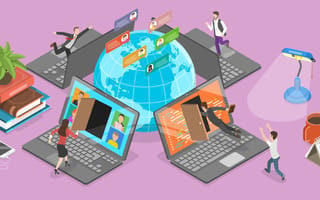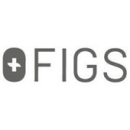Nowadays offices tend to be half full, with much of the workforce being remote and hybrid. But company culture doesn’t have to reflect that reality. Creating an engaging company culture can be done through meaningful virtual activities, meetings with intentional agendas and even occasional in-person meetups.
While many companies have embraced hybrid and remote work models, these models do still present some challenges. These challenges happen when technical hiccups arise or when employees are working asynchronously across time zones, but some companies have thought of clever solutions.
These three companies are prime examples of employers creating engaging cultures by focusing on listening, centering on their mission and thoughtful accessibility. We spoke with DISQO, Collectors and FIGS about how they ensure all their employees feel equally engaged.
DISQO is a customer experience (CX) platform empowering brands to make better business decisions through insights, agile testing and advertising measurement products.
Describe an event, ritual or activity where you saw success in engagement from both your remote and in-office workforce.
Our virtual company all-hands meeting brings all DISQO employees together once a month, no matter their location. Many of our team members log into Zoom for this live event, but we also have great in-person watch parties at our global offices, with co-workers joining from different countries and timezones.
My favorite part is the Zoom chat, which goes crazy with comments and emojis celebrating our company and department wins. Arguably the most fun section might be our “Team Member of the Month,” which usually ends in a tie.
What feedback did you receive from the participants of this event?
One of our DISQO values is transparency and in support of this, we consistently welcome authentic and honest feedback on our offerings/events. Being open to feedback and making changes to improve has allowed us to be successful and continue various events.
This year, we opened our U.S. offices using a hybrid work plan. We had a few people mention they would like more opportunities to get together around the office. I worked with our IT team to arrange a livestream watch party for our monthly meeting. We kicked it off by inviting our local employees to come early to the office.
Afterwards, my colleagues shared they felt it was a great way to view the program so we’re planning to continue it. But even with the opening of our offices and the success of these in-person events, we won’t stop offering them virtually. We want to ensure our remote employees will always be able to participate. Our regular all-hands meeting is a way for them to feel connected with the rest of our workforce.
In your opinion, what should employers be doing to create an engaging hybrid culture?
There’s a lot to consider when planning events and engagement touchpoints for employees. Starting the process well in advance and being intentional on what outcomes you would like to see are critical. Additionally, in-person and remote engagements aren’t going to be exactly the same experience, but it’s important to strive to make them equitable. Also, don’t be afraid to try something new. Get out of your comfort zone or mindset of what engagement looked like “pre-Covid-19” or “during-Covid-19.”
Collectors is a creator of innovative technology that provides value-added services for collectors worldwide. They grade, authenticate, vault and sell millions of collectibles while modernizing and digitalizing the process to further their mission of helping collectors pursue their passions.
Describe an event, ritual or activity where you saw success in engagement from both your remote and in-office workforce.
The Collective — our company’s official intranet site — launched successfully in January 2023. The Collective was created to connect team members easily, providing information, celebrations and announcements. To ensure that everyone had access to the site, we provided iPads at our Santa Ana headquarters. We encouraged engagement across all teams and made The Collective the primary platform for internal initiatives like benefits enrollment and DEIB events.
We were also thrilled with the positive results of our most recent DEIB event we organized — seminars in honor of AAPI Heritage Month. To ensure maximum participation, we arranged multiple seminar schedules, accommodating both day and night shifts. Our belief is that making such events accessible to all staff, irrespective of their shift, department or location is critical for keeping all our teams engaged and involved.
What feedback did you receive from the participants of this event?
Creating a culture of community in a hybrid workforce requires an understanding of where we can unify the experience as well as provide additional accommodations that are respective to one’s work setting but equally as engaging.
For The Collective launch, we were pleased to hear our teams were thankful to have access on-site as well as online, echoing that the information was consolidated, easy to navigate and overall a much better experience with this localized hub. Departments asked how they could be more involved and have their own page/features for teams to have access, making the information relatable across the organization.
For the AAPI seminar, we received overwhelmingly positive feedback. The focus of the seminars was on AAPI family traditions and histories, which proved to be captivating with our teams expressing appreciation for the chance to learn about and honor the AAPI community. Some even reported feeling more connected with their colleagues through the seminar. We hope to continue organizing events and developing initiatives like these that not only celebrate the diversity of our workforce but contribute to a positive and inclusive work environment.
In your opinion, what should employers be doing to create an engaging hybrid culture?
Employers should prioritize creating equitable experiences for in-person and remote employees. This means considering the needs of both groups when planning, and ensuring that the experiences offered are simple, yet creative, without being too burdensome for employees. They should consider employee needs, like shift schedules and workload, to avoid asking too much of them. Participant feedback should be collected and addressed to ensure that the activities planned are reflective of what employees actually want and need.
For in-person events, accommodations or an equal activity, can be made for the remote employees to participate virtually. Creating a virtual community internally can be a powerful way to engage remote employees and foster a sense of connection or belonging. Creating an engaging hybrid culture requires adaptability and willingness to experiment and try new things. It’s important for employers to be open to feedback and be willing to make changes as needed to continue improving the employee experience.
FIGS is a medical apparel company with a mission to create comfortable and function uniforms for medical professionals.
Describe an event, ritual, or activity where you saw success in engagement from both your remote and in-office workforce.
As a company deeply driven by our mission of serving, celebrating and supporting healthcare professions, FIGS has a uniquely strong culture. We are able to orient ourselves around this culture and mission in the world of hybrid work and we’ve found our team members are passionate and excited to gather, regardless of the format.
One of the best examples of this has been what we call our Fruitful Talks, where we invite members of our healthcare professional community to join our team to share their passions, what motivates them, and what they’d like to see more of in healthcare. While Fruitful Talks have always been part of our special sauce, we’ve seen these events come alive in a hybrid world because they foster rich and engaging opportunities for our team to connect with the HCP community in person, while still creating an equally robust experience for those joining the talks remotely.
What feedback did you receive from the participants of this event?
We’ve been super excited to see that these events are consistently some of our most well-attended — both virtually and in-person — and the feedback our team shares with us helps tell us why they work.
Our biggest feedback takeaway: The importance of both flexibility and accessibility in hybrid employee experience. Given that we work in a hybrid model, our team members really appreciate the opportunity to attend these events in more than one way, and that experience quality isn’t overlooked for those who attend at home.
Our second-biggest learning: Our team really appreciates content quality and has a keen eye on what subject matter is most impactful to them. When it comes to content quality, our team really resonates strongly with the curated content that provides a dynamic, emotive, and enriching learning experience that we aim to build with these sessions. We’re so grateful to see that when it comes to subject matter, our team organically really resonates with mission-driven opportunities to learn in nuance about the community we serve.
Two of our greatest hits have been our Pride speaker panel, where we invited several of our LBGTQIA+ ambassadors to share their candid experiences working in medicine, and our talk with Katie Duke, NP; who gave a rousing seminar about how vital the basic needs of support, value and safety are to the most trusted profession in America — nursing — and how our team can help bring about change.
In your opinion, what should employers be doing to create an engaging hybrid culture?
I believe the core of our success with Fruitful Talks comes from three key elements: listening, centering on our mission and thoughtful accessibility.
Listening to our team with regular post-program surveys has helped us hone in on what really makes the experience shine with our hybrid team no matter how they’re attending. To get it right, you have to listen.
And lastly, creating thoughtful hybrid experiences requires designing the experience with all audiences in mind, and being thoughtful about making it accessible. Listen to your team about what works and what doesn’t and do your best to make sure every attendance model feels impactful, even if they look different. Whether this means investing in tech for a great remote viewing experience, thinking of unique incentives for both in-office and at-home participation or building experiences in-event that allow people to really be present and engage, even through a screen.
While it’s not always easy, an open mind, a thoughtful approach and a sense of purpose have helped this area of our hybrid culture thrive.









